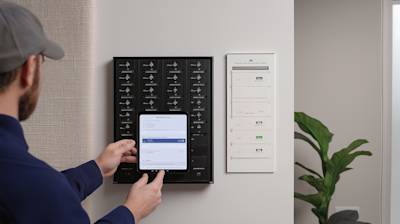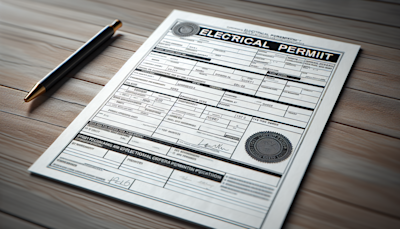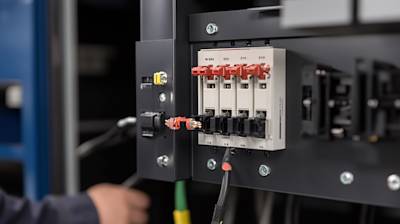Understanding Electrical Blueprint Symbols
Every electrical plan relies heavily on symbols. These often cryptic, intricate graphics represent various electrical components like wires, switches, lights, and more. These symbols are universally accepted in the electrical industry helping electricians, engineers, and architects accurately interpret and create electrical blueprints. This article strives to enhance understanding of key electrical blueprint symbols.
Importance of Electrical Blueprint Symbols
Understanding electrical blueprint symbols is crucial for anyone involved in the building industry. This symbology is the universal language among professionals such as contractors, builders, architects, and electricians. It ensures smooth execution of projects, safety, and efficient power distribution.
Moreover, knowing these symbols can prevent costly mistakes, delays, and even potential hazards. For instance, misinterpreting an electrical blueprint can lead to improper installation, which can cause circuit overloads or fires. Hence, it is necessary not only to understand these symbols but also use them accurately while creating a blueprint.
Commonly Used Electrical Blueprint Symbols
Understanding the various symbols on electrical blueprints is crucial for anyone involved in electrical engineering or construction. Below, we'll explore some of the essential symbols that frequently appear on these plans:
Lines
Lines on an electrical blueprint serve as the primary indicators of where electrical conductors are routed. They are depicted in different styles:
-
Dashed Lines: These represent concealed conductors, which are not visible on the surface, such as wiring behind walls or above ceilings.
-
Solid Lines: These show exposed conductors that are visible and accessible, like surface-mounted wiring.
Disconnected Wires
When two lines cross each other without a connecting dot, it indicates that the wires are not connected. This is an important distinction to avoid confusion with intersecting wires that do not share an electrical connection.
Connected Wires
Conversely, when two lines cross and there is a dot at the intersection, this denotes that the wires are electrically connected. This small but critical symbol can significantly impact the reading and interpretation of the circuit's functionality.
Switches
Switches are represented by a straight line that intersects the conducting line at an angle. This symbol typically indicates a switch in the 'on' position. The design and angle of the line can vary slightly depending on the type of switch (e.g., toggle, push-button, etc.) and its specific function in the circuit.
Resistors
Resistors, which are components that impede the flow of electrical current, are symbolized in two common ways:
-
Zigzag Line: This is the traditional symbol for a resistor, reflecting its function of restricting current flow.
-
Rectangle: Some modern diagrams use a simple rectangle along a conducting line to represent a resistor.
Capacitors
Capacitors, used to store electrical charge, are shown as two parallel lines on a conducting line. These lines may be spaced differently depending on the type and value of the capacitor. The symbol effectively illustrates the capacitor's role in the circuit, often involved in stabilizing voltage and power flow.
Battery
The battery is depicted with multiple pairs of short and long parallel lines. This symbol reflects the battery's structure, consisting of multiple cells (represented by pairs of lines), which store and supply electrical energy.
Different Types of Electrical Switch Symbols
In electrical blueprints, switches are critical components that control the flow of electricity within a circuit. Each type of switch has a unique symbol that reflects its specific function and characteristics. Below, we explore some of the common types of switches and their corresponding symbols:
Single Pole Switch: The single pole switch is one of the most basic types of switches used in electrical systems. It controls a circuit from a single location. The symbol for a single pole switch is represented by a simple break in the line with an angle. This symbol shows that the switch can interrupt or continue the circuit, allowing it to control a device from one location.
Double Pole Switch: A double pole switch is used to control a circuit from one location, but it can handle two wires and, consequently, can control two circuits or a device with a higher capacity. The symbol consists of two parallel single pole switch symbols, indicating that it can independently control two different circuits from a single point. This setup is often used for larger appliances or in industrial settings where more robust control is needed.
Three-Way Switch: Three-way switches are used to control a single function from two different locations. This type of switch is commonly found in hallways or staircases, where you can turn on and off the lights from either end. The symbol for a three-way switch includes a break in the line, an angle, and a point. This illustrates the switch's ability to toggle the connection between two different points, facilitating control from multiple locations.
Four-Way Switch: Expanding on the functionality of three-way switches, the four-way switch allows for control from three or more locations. Typically used in large rooms or multi-entry hallways, its symbol features a cross-shaped configuration that connects the lines from three different directions. This design indicates its ability to interact with multiple three-way switches to control lighting or other electrical functions from multiple locations.
Dimmer Switch: The dimmer switch, used to adjust the brightness of lighting fixtures, is symbolized by a standard switch line with an added wavy line intersecting it. This symbol reflects the switch's ability to modulate electrical flow, allowing for the adjustment of light levels within a space. Dimmer switches add a level of flexibility and comfort in residential and commercial settings.
Push Button Switch: A push button switch, which controls a circuit with a simple push-and-release mechanism, is represented by a circle or square around the break in the line. This symbol highlights the temporary or permanent contact made by the button, commonly used in doorbells, buzzers, and other similar applications.
Fulfilling The Role of Circuit Breaker Symbols
Circuit breakers are essential safety devices in electrical systems, designed to prevent overload and short circuits. Their symbols vary depending on the type and rating:
Thermal Circuit Breaker: Symbolized by a rectangle with a curved line inside, the thermal circuit breaker reacts to heat caused by excess current. This breaker is designed to interrupt the circuit when the internal temperature exceeds a predefined limit.
Magnetic Circuit Breaker: This type features a rectangle intersected by a line with a triangle pointing towards the line. The magnetic circuit breaker operates using an electromagnet—its strength increases with the current, triggering a mechanism that breaks the circuit during high-current conditions.
Thermal Magnetic Circuit Breaker: Combining the features of both the thermal and magnetic types, this breaker is represented by merging the symbols of the thermal and magnetic breakers. It provides dual protection mechanisms, reacting to both excessive current (magnetic) and prolonged overload (thermal), making it highly effective for a variety of applications.
Significance of Light and Outlet Symbols
Lighting and outlet symbols are vital for indicating electrical fixtures in blueprints:
Light Fixtures: hese are typically represented by circles, sometimes containing lines or arrows extending outward to illustrate the direction of light. This symbol helps in identifying where light sources are positioned within a space.
Receptacle Outlet: A receptacle outlet, used to connect electrical devices, is symbolized by a small rectangle. This straightforward symbol denotes the point where power is accessible for appliances and electronics.
Duplex Receptacle Outlet: For a duplex receptacle outlet, which includes two sockets, the symbol features two small rectangles parallel to each other. This indicates a single unit that can accommodate two plugs, commonly used in residential and commercial settings.
While this guide provides some basic understanding of electrical blueprint symbols, there's much more to learn; each symbol has its specific purpose and meaning. Having a comprehensive understanding of these symbols ensures effective communication between all parties involved in the construction process. Always refer to the symbol legend in a set of blueprints, as some symbols may change based on the engineer or designer in charge of the project.
Frequently Asked Questions about Electrical Blueprint Symbols
What are the typical electrical blueprint symbols used in drawings?
Educating yourself about the electrical blueprint symbols is vital for reading drawings or entire blueprints. Some standard symbols include those for outlets, switches, circuits, panels, telecommunication systems and other electrical systems. They provide insight into where each item should be installed and also show how to connect them.
What does the electrical symbol for a light switch look like?
The electrical blueprint symbol for a light switch resembles a pencil or an exclamation point with a perpendicular line circularly connected around the midpoint. This symbol is typically represented in its on-position on blueprints.
Are wiring symbols the same as electrical symbols?
While they have a lot in common, there's a subtle difference between wiring symbols and electrical symbols. Electrical symbols are more general and refer to any symbols used in electrical plans. On the other hand, wiring symbols are a subset of electrical symbols specifically designed to illustrate wiring configurations.
What does the electrical symbol for wiring look like?
The electrical symbol that represents wiring in a blueprint generally looks like a solid or dashed line connecting various components. Sometimes, texts or numbers are used alongside the lines to specify the type of wire and illustrate more information related to the wiring.
Are there any online resources to learn about electrical blueprint symbols?
Yes, various online resources exist for those interested in learning about these essential symbols. Websites like 'electrical-symbols.com' offer comprehensive lists of electrical symbols, their meanings, and their uses. Moreover, paid and free online courses from platforms such as Coursera, Udemy, and Khan Academy provide comprehensive and structured training on this topic.
Why is an understanding of electrical blueprint symbols important?
An understanding of electrical blueprint symbols is crucial for anyone involved in the field of electrical engineering or those who wish to work on DIY electrical projects. Printed symbols on a set of plans provide complete information about the electrical system to be installed. Without knowledge of these symbols, you may encounter confusion, project delays, and errors.
How are grounding symbols represented in electrical blueprints?
Grounding symbols may vary, but they typically appear as a series of downward-pointing triangles or arrows. They may also look like a vertical line with three horizontal lines branching from its bottom. These symbols are an essential part of electrical blueprints since they provide safety precautions for electrical systems.
Is it necessary to consult a professional for understanding electrical blueprint symbols?
Usually yes, consulting an engineer or an experienced electrician can be helpful, particularly for complex projects. However, with right resources and enough patience, one can also learn to understand basic symbols by themselves. Remember that misinterpretation can lead to dangerous situations during installation or maintenance, so always double-check your understanding of these electrical blueprint symbols.
Can I design an electrical blueprint without knowing these symbols?
Without knowledge of electrical blueprint symbols, crafting an accurate and safe electrical blueprint can be quite a challenge. These symbols serve as a universal language in the field of electrical engineering and are essential for communicating schematics efficiently. Therefore, knowledge of these symbols is crucial.
Are there any apps to understand electrical blueprint symbols?
Yes, there are numerous educational mobile apps available to help students and professionals learn and understand electrical blueprint symbols. These apps provide interactive learning experiences and include quizzes to assess the learners' understanding of the topic.
Pros of Electrical Blueprint Symbols
Standardization and Consistency
-
Electrical blueprint symbols create a universal language that professionals from all over the world can understand. This allows engineers, electricians, architects, and other professionals to communicate their designs effectively regardless of language barriers.
-
These symbols ensure consistency in blueprints. The same symbol signifies the same element across various blueprints, contributing to easier and quicker comprehension.
Efficiency
-
Utilizing electrical blueprint symbols is a time-saving approach as it eliminates the need to illustrate intricate circuitry details.
-
It also aids in efficiency of work, as codes and symbols speed up the process of interpreting an electrical plan.
Accuracy and Precision
-
The use of standardized symbols helps in avoiding errors, aiding professionals in creating precise schematics. They can effectively express complex circuits and other details that might get lost in translation.
-
Electrical blueprint symbols provide a clear representation of the electrical elements to be installed, reducing the likelihood of misunderstandings and potential errors during the construction phase.
Cons of Electrical Blueprint Symbols
Learning Curve
-
One of the drawbacks of electrical blueprint symbols is the initial learning process. For someone who is new to the field, memorizing and understanding the various symbols can be quite challenging.
-
Some symbols have similar appearances but different meanings, which can cause confusion or mistakes.
Variations and Complexities
-
While the use of symbols standardizes electrical blueprinting, some symbols can differ across regions. These geographical variations may result in misunderstanding, hence slowing down the work process.
-
As technology advances, new elements are introduced into electrical systems, which may require the creation and learning of new symbols. This continuous change can be hard to keep up with, particularly for those who are not actively involved in the field.
Over-reliance on Symbols
-
Excessive use of symbols in electrical blueprints can lead to a complicated and cluttered design. Too many symbols used together can make a blueprint difficult to read and understand.
-
An over-reliance on symbols could result in a lack of detailed instructions within the blueprint, leaving room for errors in interpretation.
Summary
Understanding electrical blueprint symbols is key to decoding the inner workings of a building's electrical plan. Each of these symbols is essentially a coded language, representing a specific electrical component or connection. They provide visual clues and abbreviations for everything from the smallest detail like a switch or an outlet to large appliances or complex systems. Decoding these symbols can give you a clear picture of the electrical system in the structure, whether it's a small home or a large commercial building.
When it comes to learning electrical blueprint symbols, there is a real need for electricians, engineers, architects, and even homeowners who wish to understand and effectively read blueprints. Without this knowledge, making necessary changes or fixing potential issues can be a daunting task. Remember, these symbols act as the universal language in the electrical world. So, to be effective in the field, it's highly important to get a good grip on these symbols.
Finally, while the process of understanding electrical blueprint symbols might seem overwhelming at first, with practice and regular use, it will become like second nature. In time, you'll find your ability to read and interpret these symbols improves, simplifying your work and helping ensure the safety and functionality of every project. Therefore, investing some time in learning these symbols can really pay off in the long run, paving the way for smoother, more efficient work in any electrical project.
About Sagan Electric
Welcome to Sagan Electric! Based in sunny Sacramento, CA, our company has been lighting up the lives of our clients for years. Our team is composed of professional, experienced electricians who are dedicated to providing you with the best electrical solutions. Whether you're renovating your home or setting up a new office, we've got all your electrical needs covered. We believe in offering top-notch services and maintaining a strong, lasting relationship with our clients. That's the Sagan Electric way!
Tags: electrical symbols, blueprint, electrical plans,








